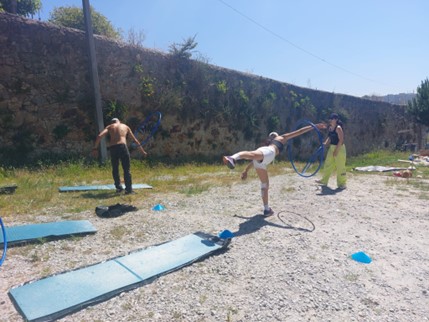
The activity to test the guidelines of the PUSH project took place in Porto’s Assisted Consumption Room in the last week of May 2024. It was a session dedicated to homeless people who use psychoactive substances. This activity was led by an experienced physical education teacher and accompanied by the technical social support team. It took place outdoors, outside the hall, where there is a private garden area.
A physical activity session was held based on the following points:
- Flexibility training: for breathing and stretching, working on body awareness;
- Localized Gymnastics: for training muscle tone, with weights and dumbbells; training with hula Body work on muscle tone and movement, collective skills and interaction with the group;
- Adapted Mobility Training: for individual training with participants who have health problems, motor mobility difficulties or some kind of physical disability. The trainer has adapted various low-impact physical and physiotherapeutic exercises. Highly inclusive work, according to the individual needs of the participants;
- Free Movement/Football: for training physical skills linked to cardiac endurance and social skills, such as developing group awareness, sharing, empathy and healthy competitiveness.
With regard to the main positive aspects, participants report significant physical and mental benefits from physical activity. They also highlighted the positive interactions between the participants, since, in the context of the consumption room and due to their condition, they feel that these moments are essential for establishing relationships of trust. At the same time, the bonds between the participants, the social workers and the trainers become closer. The context of the activities, especially outside, serves as an “unblocker” to address other problems or issues related to their integration. Also the fact that homeless people with physical disabilities or health problems have found an inclusive response to their condition.
There are also some points for improvement, such as creating more friendly and safe places to practice physical activity, as well as adapting timetables to the specific characteristics of the population and addictive consumption. With regard to the availability of specialized human resources, it is suggested that a reserve team of volunteers be set up and that vacancies be surveyed. In addition, reinforced food resources and hygiene kits are essential for the participants.
As someone said, (sports) “it’s a good addiction”.

